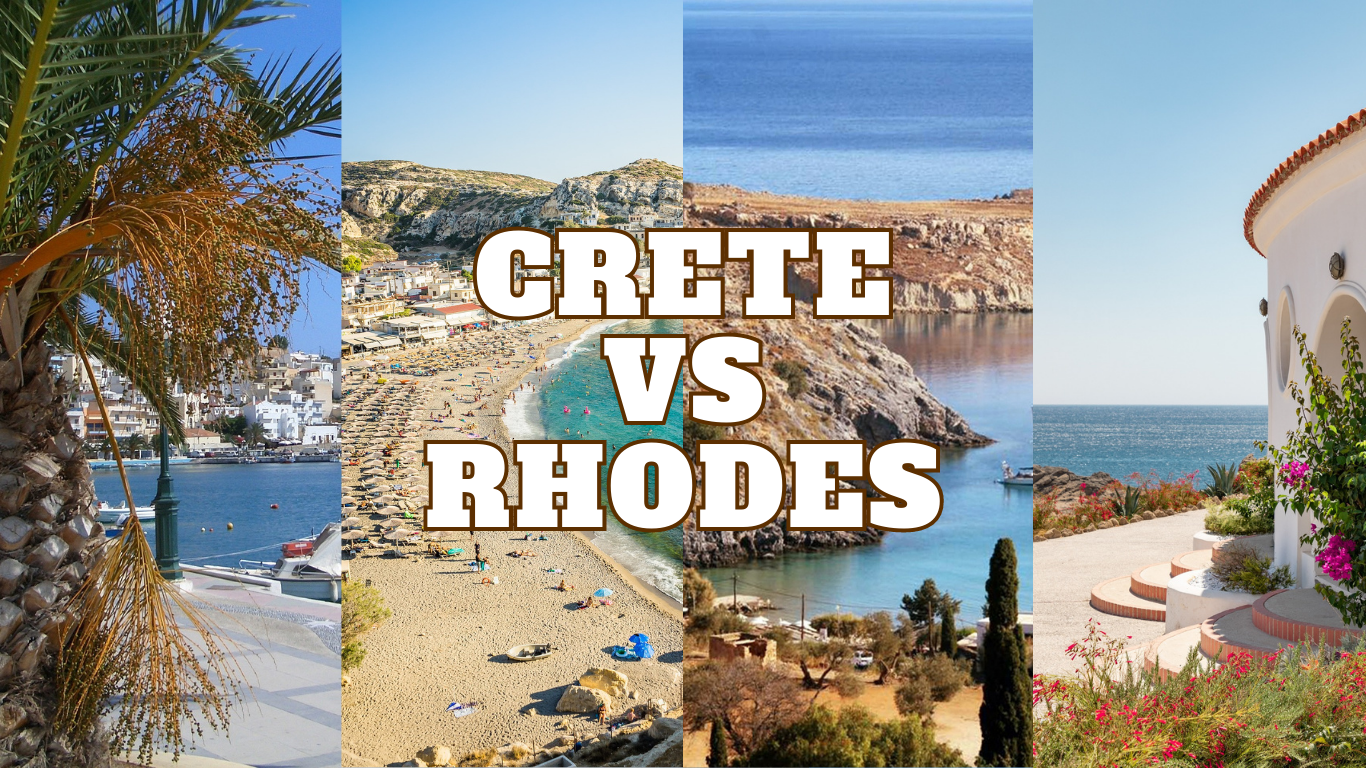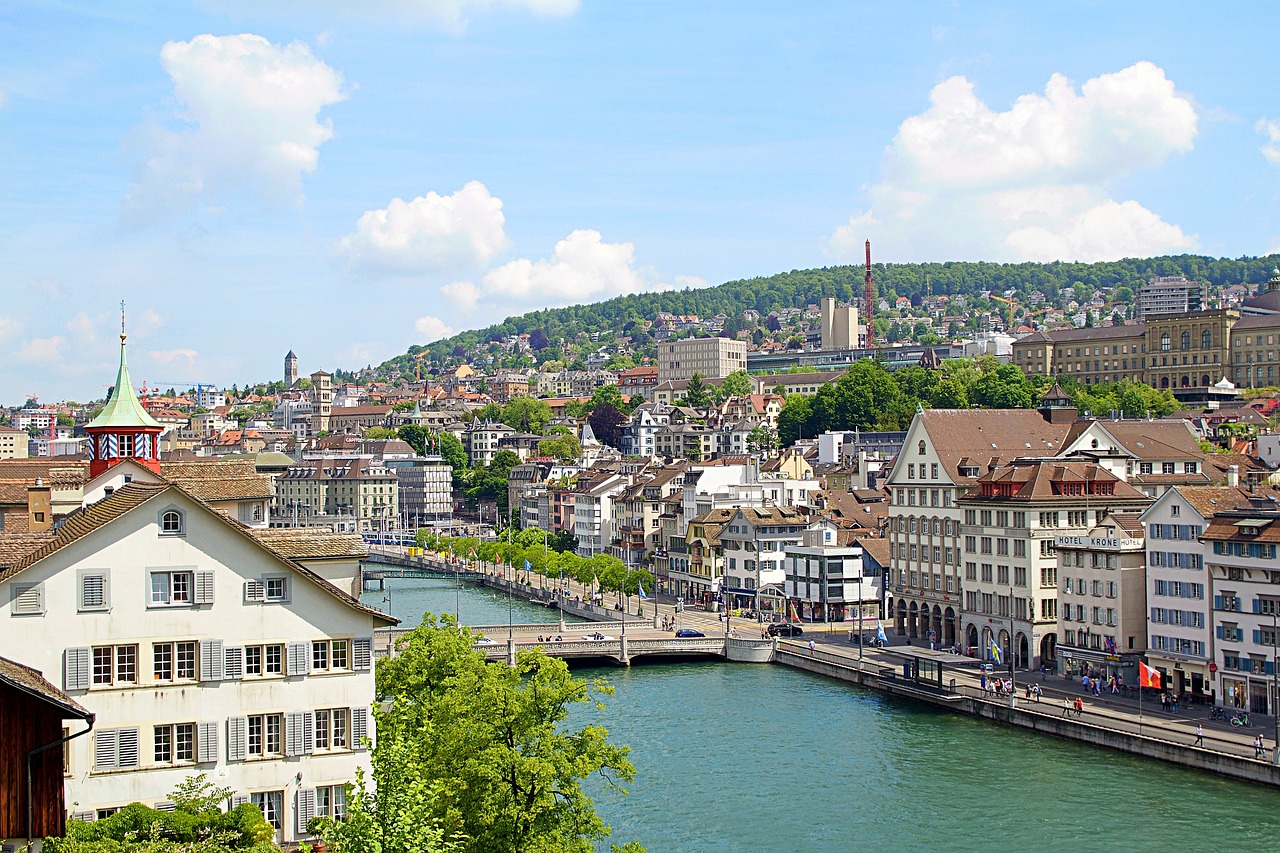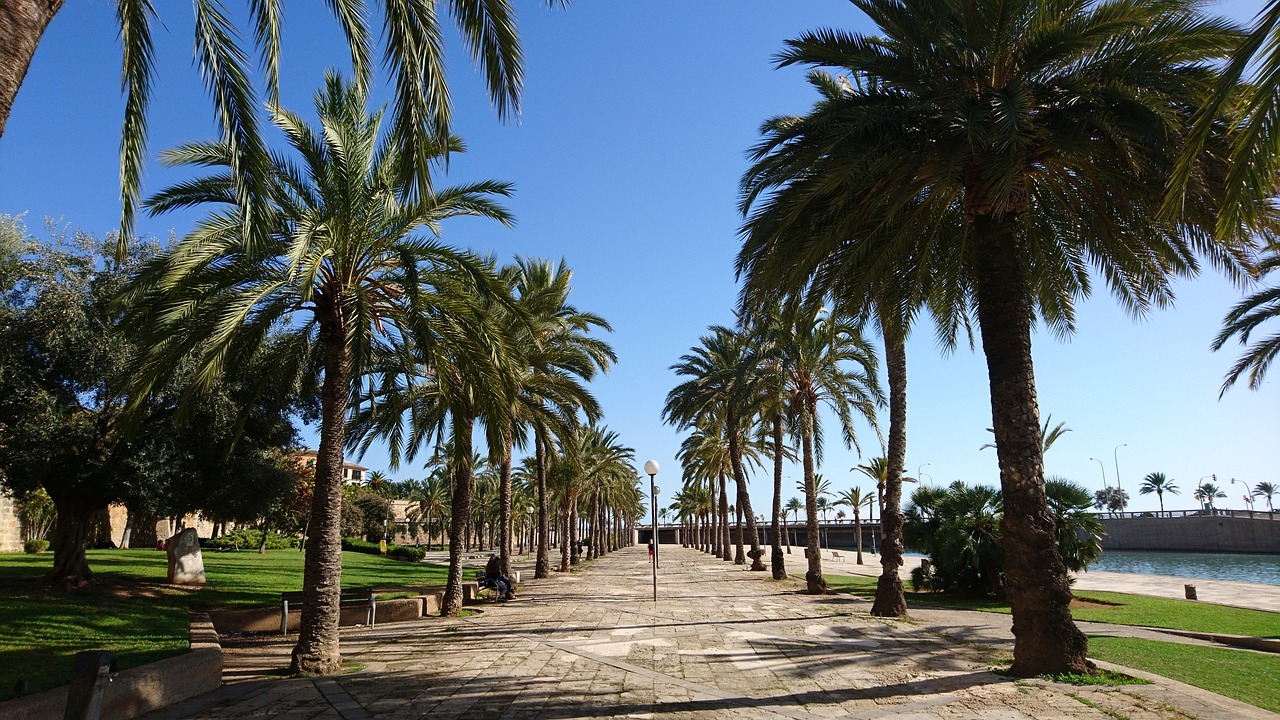Crete and Rhodes are both beautiful Greek islands with a rich history and culture. While they share some similarities, there are also some key differences between the two destinations.
Size and Location
Crete is the largest island in Greece and the fifth largest island in the Mediterranean Sea, with a total area of approximately 8,300 square kilometers, while Rhodes is the fourth largest Greek island, with a total area of approximately 1,400 square kilometers.
Crete is located in the southern part of the Aegean Sea, between the mainland of Greece and North Africa, while Rhodes is located in the southeastern part of the Aegean Sea, near the coast of Turkey.
While both islands are located in the Aegean Sea, Crete is significantly larger than Rhodes, and its size allows for more diverse landscapes and attractions. However, Rhodes has the advantage of being more centrally located and easily accessible from other parts of Greece and Turkey.
History
Crete and Rhodes both have a rich history that dates back to ancient times.
Crete is known for its Minoan civilization, which is one of the oldest in Europe. The Minoan civilization was a Bronze Age civilization that flourished on the island from around 2700 BC to 1450 BC. Crete was also an important center of the ancient Greek civilization and was ruled by various civilizations throughout its history, including the Romans, Byzantines, and Venetians.
Rhodes, on the other hand, was home to the Colossus of Rhodes, one of the Seven Wonders of the Ancient World. The Colossus was a giant statue of the Greek god Helios that stood at the entrance to the harbor of Rhodes. The island was also an important center of trade and commerce during the Hellenistic period and was ruled by various civilizations, including the Ottomans and Venetians.
Both Crete and Rhodes have a history of being invaded and ruled by various civilizations, and their strategic location made them important centers of trade and commerce throughout history. Today, both islands are known for their rich cultural heritage and offer visitors a glimpse into their fascinating past through archaeological sites, museums, and historic landmarks.
Beaches
Crete and Rhodes both have beautiful beaches with crystal-clear waters and stunning natural scenery, that are sure to take your breath away.
Crete has more beaches than Rhodes, and some of them are considered to be among the best in the world. Some of the most popular beaches in Crete include Elafonisi, Balos, and Vai. These beaches are known for their white sand, turquoise waters, and breathtaking natural landscapes.
Rhodes also has beautiful beaches, but fewer in number than Crete. Some of the most popular beaches in Rhodes include Faliraki, Lindos, and Tsambika. These beaches are known for their crystal-clear waters and stunning natural beauty.
One advantage of Rhodes over Crete when it comes to beaches is that some of its beaches are more easily accessible, and the island is smaller, making it easier to travel from one beach to another. However, Crete’s vast coastline offers a wider range of beaches, from secluded coves to wide stretches of sand.
Attractions
Crete and Rhodes offer a wide range of attractions that appeal to different types of travelers.
Crete is known for its natural beauty, including the Samaria Gorge and the White Mountains, as well as its archaeological sites, such as the Palace of Knossos. The island is also home to traditional mountain villages, where visitors can experience the island’s unique culture and cuisine.
Rhodes, on the other hand, is known for its medieval Old Town, the Valley of the Butterflies, and the ancient city of Lindos. The island is also famous for its beautiful beaches, water sports, and vibrant nightlife.
While both islands offer a range of natural and historic attractions, Crete has a wider range of archaeological sites and traditional villages, making it a better destination for history and culture buffs. Rhodes, on the other hand, has a more cosmopolitan vibe and is better suited for travelers looking for a combination of history, nature, and nightlife.
Overall, both islands offer unique experiences and attractions that are sure to make your trip unforgettable.
Nightlife
Both Crete and Rhodes have a lively nightlife scene, with many bars and clubs catering to tourists. However, Rhodes is considered to be more party-oriented, while Crete offers a more diverse range of nightlife options.
In Crete, the nightlife is diverse and spread out across the island. The most popular nightlife destinations in Crete include the city of Chania, Malia, and Hersonissos. Chania has a more laid-back nightlife scene, with a range of bars and restaurants overlooking the Venetian harbor, while Malia and Hersonissos are known for their lively party atmosphere, with numerous bars and clubs that stay open until the early hours of the morning.
Rhodes, on the other hand, is considered to be more entertainment-oriented than Crete. The island has a more concentrated nightlife scene, with many bars and clubs located in the capital city of Rhodes and the popular tourist resort of Faliraki. The nightlife in Rhodes is known for being lively, with many clubs staying open until the early hours of the morning.
Overall, both Crete and Rhodes offer a lively nightlife scene, but the style of nightlife is different between the two islands. Crete offers a more diverse range of nightlife options, from laid-back bars to lively clubs, while Rhodes is more focused on the party atmosphere with a concentrated nightlife scene in certain areas.
Climate
Crete and Rhodes both have a Mediterranean climate with hot summers and mild winters. However, there are some differences in their climate – Rhodes tends to be drier and warmer than Crete, which can be more temperate and humid.
Crete tends to have a more temperate and humid climate, with milder temperatures in the summer due to its large size and mountainous terrain. The island experiences some rainfall throughout the year, but the driest months are from June to September. The winter months can be mild but wet.
Rhodes, on the other hand, has a drier and warmer climate than Crete due to its smaller size and more southern location. The island experiences very little rainfall, particularly in the summer months, and has long, hot, and dry summers. The winter months are milder and drier than in Crete.
Overall, both Crete and Rhodes have a pleasant Mediterranean climate, but the differences in their climate can affect your experience on the islands. Crete’s more temperate climate may be more comfortable for those who prefer cooler temperatures, while Rhodes’ warm and dry climate may be more suitable for those looking for a hotter and sunnier destination.
Food
Crete and Rhodes both offer delicious traditional Greek cuisine, but there are some differences in their food.
Crete’s cuisine is known for its rustic and simple dishes, often made with local ingredients such as olive oil, herbs, and cheese. Some of the most popular Cretan dishes include dakos, a salad made with tomatoes and barley rusk, and boureki, a pie made with zucchini, potatoes, and cheese. Cretan cuisine also includes a range of meat and seafood dishes, often cooked in a clay pot or grilled over charcoal.
Rhodes, on the other hand, offers more refined and creative dishes, with a focus on seafood and Mediterranean flavors. Some of the most popular Rhodesian dishes include koulouria, a type of sesame bread, and meze, a selection of small dishes often served as appetizers. The island is also known for its desserts, such as baklava and karydopita, a walnut cake.
Both Crete and Rhodes offer delicious Greek cuisine, but the style of food is different between the two islands. Crete’s cuisine is more rustic and traditional, while Rhodes offers a more refined and creative cuisine. The choice between the two destinations will depend on your personal preferences and what type of Greek cuisine you prefer.
Accessibility
Crete and Rhodes are both accessible by air and sea, but there are some differences in their accessibility. Crete is more accessible than Rhodes, with multiple airports and ports throughout the island, making it easier to get around and explore. Rhodes, on the other hand, has one main airport and port, which can make it more difficult to travel to and from the island.
Crete has two major airports, Heraklion International Airport and Chania International Airport, with direct flights from major European cities. The island is also accessible by ferry from Athens and other Greek islands. Crete is a large island, and transportation between cities and towns can take time due to the mountainous terrain and winding roads.
Rhodes also has an international airport, Diagoras International Airport, with direct flights from major European cities. The island is accessible by ferry from Athens and other Greek islands as well. Rhodes is a smaller island than Crete, and transportation is relatively easy, with a good network of roads and public transportation.
Overall, both Crete and Rhodes are relatively accessible, with good air and sea connections. Crete is a larger island, and transportation between cities and towns can take longer than on Rhodes due to the terrain. Rhodes is a smaller island, and transportation is relatively easy. The choice between the two destinations will depend on your personal preferences and what type of transportation you prefer.
Tourism
Crete and Rhodes are both popular tourist destinations in Greece, but there are some differences in their tourism. Rhodes tends to be more crowded and touristy than Crete. This can make it harder to find secluded beaches and quiet spots to relax.
Crete is a larger island and offers a wide range of attractions, including stunning beaches, archaeological sites, and traditional villages. The island attracts a diverse range of tourists, from families to backpackers. Crete is known for its laid-back and welcoming atmosphere, with a range of accommodations to suit different budgets.
Rhodes, on the other hand, is known for its medieval Old Town, beautiful beaches, and vibrant nightlife. The island attracts a younger crowd and is more oriented towards nightlife and entertainment. Rhodes offers a wide range of hotels and resorts, from budget-friendly to luxury accommodations.
Overall, both Crete and Rhodes offer unique experiences and attractions for tourists. Crete is a better destination for those looking for a wider range of attractions, including archaeological sites and traditional villages, while Rhodes is more suitable for those looking for a combination of history, nature, and nightlife.
Prices
Crete and Rhodes are both popular tourist destinations in Greece, but there are some differences in their prices.
Crete tends to be a more affordable destination than Rhodes, particularly for food and accommodations. While there are some luxury hotels and restaurants on the island, there are also many budget-friendly options available, particularly in smaller towns and villages. Crete also offers a range of free attractions, including beaches and hiking trails.
Rhodes, on the other hand, can be a more expensive destination, particularly in the popular tourist areas such as Rhodes Town and Faliraki. The island has a higher concentration of luxury hotels and restaurants, and prices for food and drinks can be higher than on Crete. However, there are also budget-friendly accommodations and dining options available in smaller towns and villages.
Overall, Crete is generally a more affordable destination than Rhodes, particularly for budget-conscious travelers. However, there are still ways to enjoy Rhodes without breaking the bank, particularly by exploring some of the island’s smaller towns and villages.
Culture
Crete and Rhodes both have have their own distinct cultures and traditions, and a rich cultural heritage, but there are some differences in their culture. Crete is known for its music, dance, and poetry, while Rhodes is known for its architecture, art, and crafts.
Crete has a unique culture and identity, with a history that dates back to ancient times. The island has a strong culinary tradition, with a focus on local ingredients and recipes passed down through generations. Crete is also known for its traditional music and dance, which is often performed during festivals and celebrations. The island has a warm and welcoming culture, with locals who are proud of their heritage and eager to share it with visitors.
Rhodes, on the other hand, has a rich cultural heritage that reflects its long and varied history. The island has been influenced by various civilizations, including the ancient Greeks, Romans, and Byzantines. Rhodes is particularly known for its medieval history, which is reflected in its architecture and landmarks. The island also has a lively music and dance scene, with traditional Greek and Turkish influences.
Overall, both Crete and Rhodes have rich cultural heritages that are reflected in their cuisine, music, and traditions. Crete’s culture is more focused on its unique identity and traditions, while Rhodes’ culture is more influenced by its diverse history and cultural influences.
Conclusion
Both Crete and Rhodes are beautiful Greek islands with a rich history and culture, stunning beaches, and a lively nightlife, that offer unique experiences and attractions. While Crete is larger and has more accessible beaches, Rhodes has a more refined and cosmopolitan atmosphere, and is known for its medieval Old Town and ancient ruins. Ultimately, the choice between the two destinations will depend on your personal preferences and interests, but both islands offer unique experiences and attractions for visitors.



